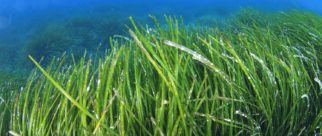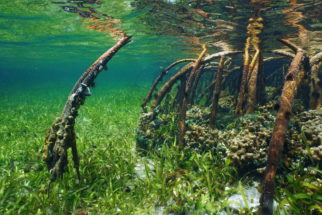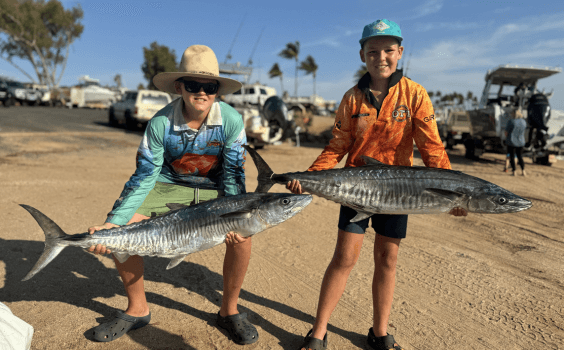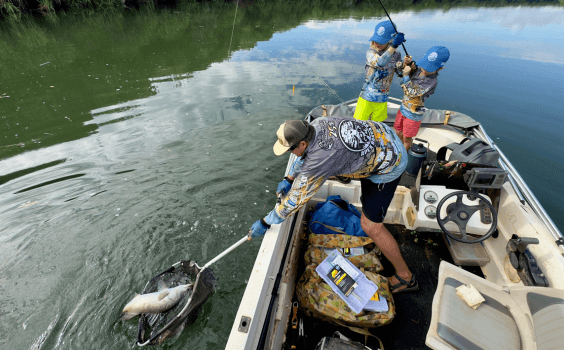Author: Dr Elizabeth Sinclair, University of Western Australia.
Healthy seagrass meadows play a big part in making some of the inshore and sheltered water fishing in WA so good, writes Dr Elizabeth Sinclair, University of Western Australia.
In fact, research has suggested 400 square meters of seagrass can support up to 2000 tonnes of fish a year (Lloyd, 1996).

The total number and diversity of fish is limited by the amount of habitat available to them with seagrass providing essential habitat for juvenile fish. Many fish and squid also attach their eggs to seagrass leaves offering them protection and a higher rate of survival. Recent research has also shown that squid numbers are highest around seagrass meadows with mixed species of seagrass.
“When you take a second to think that King George whiting, aquid, blue swimmer crabs and many of our favourite species are best targeted over seagrass areas the picture starts to become very clear,” Recfishwest Habitat Officer Michael Tropiano said.
“The more extensive and healthy seagrass meadows are, the more of these species that will mature to adult size and add to healthy fisheries.”
Even if you don’t spend your time targeting some of these WA favourites, many other species require seagrass habitat to complete some stage of their life cycle.
Seagrass meadows grow along the coastal margins of all continents around the globe, except Antarctica, forming the ‘forests of our oceans’ and providing essential services that directly influence coastal environments.
Healthy seagrass habitat helps maintain water quality, essential structural habitat, food for fish and crustaceans, and they protect our beaches and coastlines from erosion. However, marine environments are changing and declining health of fish habitats can have a real impact on fisheries and fishing.
The health of seagrass habitats are affected by water quality and changes in climate, the same factors that can be linked to fish die-offs.

Development around coastlines and estuaries has put stress on local seagrasses and has meant we have lost huge amounts of this productive habitat.
This includes losses of 33 per cent of the seagrass from the Swan River, about 80 per cent from Cockburn Sound, and an estimated 66 per cent and 46 per cent respectively from Princess Royal Harbour and Oyster Harbour in Albany (Kendrick et al. 2002; Bastyan, 1986; Walker & McComb, 1992).
Seagrass restoration is a time-consuming and costly activity, particularly with our large, slow-growing, cooler water species. Successful methods to regrow some of our seagrasses have been developed to recover lost seagrass habitat in Western Australia and these restoration sites need maintenance and monitoring to ensure they continue to expand.
However, it is much easier to look after the seagrass we have, and our direct actions can make a difference, particularly locally to protect seagrass habitat:
- Do your part to ensure good water quality and avoid fertilising your garden when there is rain around, more great tips on how you can do your part to ensure a high water quality for seagrass and crabs can be found here;
- Be aware of where the seagrass is – avoid anchoring in it and driving through shallow meadows which may create propeller scars (and damage your motor); and,
- Investigate opportunities to install seagrass friendly moorings for your boat.
The damage done to seagrasses from a single boat mooring, or propeller scar is small. But the additive effects of multiple moorings, or multiple propeller scars, cut the meadow into smaller pieces.
Seagrasses often die back from these scar edges and water flow increases allowing sediment (sand) to move more freely, making it impossible for new seagrass to grow.
Time lapse evidence from Google Earth show the impact of marinas on seagrass meadows which continue to decline with time as mooring scars open up and join, eventually leading to a complete loss, meaning less habitat for fish.
As an individual, you can take simple actions to protect seagrass habitats, improve local fisheries and fishing for future generations.
What we do on a local scale adds up. We can make a difference!
References:
Bastyan GR (1986) Distribution of seagrass in Princess Royal Harbour and Oyster Harbour on the south coast of Western Australia. Technical Series 1. Department of Conservation and Environment, Western Australia.
Kendrick GA, Aylward MJ, Hegge BJ, Cambridge ML, Hillman K, Wyllie A, Lord DA (2002) Changes in seagrass coverage in Cockburn Sound, Western Australia between 1967 and 1999. Aquatic Botany 73: 75−87
Lloyd D (1996) Seagrass: A lawn too important to mow. Sea Notes, Great Barrier Reef Marine Park Authority.
Walker DI, McComb AJ (1992) Seagrass degradation in Australian coastal waters. Marine Pollution Bulletin 25: 191–195
Banner image: Rich Carey / Shutterstock





